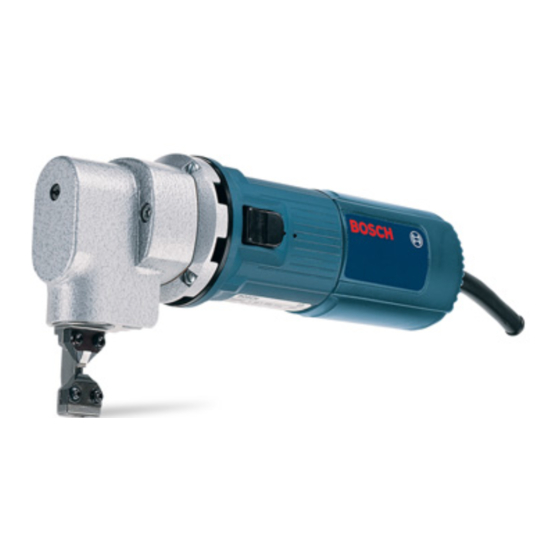Bosch 1534 Panduan Petunjuk Pengoperasian/Keselamatan - Halaman 5
Jelajahi secara online atau unduh pdf Panduan Petunjuk Pengoperasian/Keselamatan untuk Alat Listrik Bosch 1534. Bosch 1534 25 halaman.

• Do not use dull or damaged punch and dies or
accessories not intended for a nibbler. Replace
worn punches and dies immediately.
• Do not touch punch and die during use of the
nibbler.
• Never place the tool down until the punch has
come to a complete stop.
Some dust created by
power sanding, sawing,
grinding, drilling, and other construction
activities contains chemicals known to cause
cancer, birth defects or other reproductive
harm. Some examples of these chemicals
are:
• Lead from lead-based paints,
• Crystalline silica from bricks and cement and
other masonry products, and
• Arsenic and chromium from chemically
treated lumber.
Your risk from these exposures varies, de-
pending on how often you do this type of work.
To reduce your exposure to these chemicals:
work in a well ventilated area, and work with
approved safety equipment, such as those dust
masks that are specially designed to filter out
microscopic particles.
Double Insulated Tools
• Double Insulation
used in electric power tools which eliminates
the need for the three wire grounded power cord
and grounded power supply system. It is a
recognized and approved system by
Underwriter's Laboratories, CSA and Federal
OSHA authorities.
IMPORTANT:
Servicing of a tool with
double insulation requires care and knowledge
of the system and should be performed only by
a qualified service technician. WHEN SER-
VICE IS REQUIRED USE ONLY IDENTI-
CAL REPLACEMENT PARTS.
POLARIZED PLUGS: If your tool is equipped
with a polarized plug (one blade is wider than
the other), this plug will fit in a polarized outlet
only one way. If the plug does not fit fully in the
outlet, reverse the plug. If it still does not fit,
contact a qualified electrician to install the
proper outlet. To reduce the risk of electric
shock do not change the plug in any way.
BM 1609929552 8/01
• Replace damaged cords immediately. Use of
damaged cords can shock, burn or electrocute.
• If an extension cord is necessary, a cord with
adequate size conductors should be used to
prevent excessive voltage drop, loss of power
or overheating. The table below shows the
correct size to use, depending on cord length
and amperage rating on the tool's nameplate. If
in doubt, use the next heavier gauge. Always
use U.L. and CSA listed extension cords.
Note: The smaller the gauge number, the larger
"SAVE THESE INSTRUCTIONS"
is a design concept
Following a few simple tips will reduce wear on
the tool and the chance of injury to the user.
With the tool unplugged from the power supply
and the ON/OFF Switch 1 in the "OFF" posi-
tion, become familiar with handling the nibbler
and learning the location of its parts.
Before running the nibbler, inspect the punch
and die for excessive wear, and replace if nec-
essary.
Do not exceed recommended capacities for this
nibbler. Premature punch and die failure will
occur when the nibbler is under- or over-gaged.
• Never start the nibbler with the punch and die
in contact with the material being cut.
For clean and fast cuts, hold the nibbler so that
the cutting head is at a right angle to the cutting
path, with the body of the tool parallel to the
corrugations. Move the cutting head in and out
of the corrugations, constantly keeping the head
at a right angle to the material being cut.
5
5
Extension Cords
Ampere Rating (shown on nameplate)
0-
2.1-
3.5-
5.1-
2.0
3.4
5.0
7.0
25'
18
18
18
18
50'
18
18
16
16
75'
18
18
16
14
100'
18
16
14
12
150'
16
14
12
12 Wire Gauge
the wire is in the cord.
Operating the Tool
General Information
9/5/01, 2:23 PM
7.1-
12.1-
12.0
16.0
16
14
14
12
12
10
10
